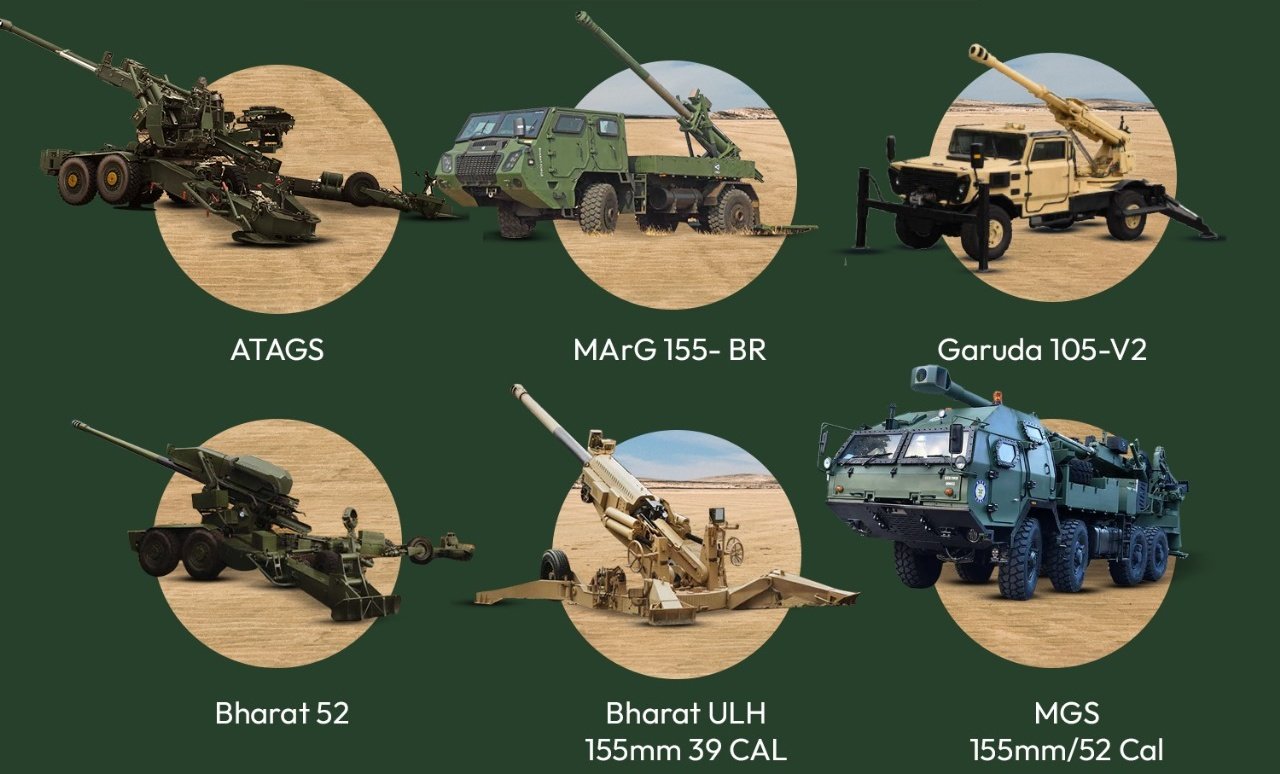Idrw Team
SOURCE: IDRW.ORG


At Aero India 2025, Bharat Dynamics Limited (BDL), in collaboration with the Defence Research and Development Organisation (DRDO), showcased its latest indigenous innovation—the Prabha Laser Beam Rider Guided Missile (LBRGM). This advanced anti-tank guided missile (ATGM) system marks a significant step forward in India’s quest for self-reliance in defense technology, offering a versatile and precise solution for modern battlefield requirements. Designed to enhance the Indian Army’s capabilities, the Prabha missile demonstrates India’s growing prowess in developing sophisticated weaponry tailored to its unique operational needs.
The Prabha LBRGM is an indigenously designed wireless ATGM system that leverages laser beam riding guidance technology, a proven method for precision targeting. Unlike fire-and-forget systems, laser beam riding guidance ensures the missile follows a laser beam directed at the target, offering high accuracy and resistance to countermeasures. The missile’s design makes it suitable for deployment from Infantry Combat Vehicles (ICVs) and ground-based launchers, providing flexibility across various combat scenarios.
Continue readingSOURCE: IDRW.ORG


At Aero India 2025, held in Bengaluru from February 10-14, Zen Technologies, a leading Indian defense technology company, showcased its cutting-edge Airborne Killer Drone System, a vertical takeoff and landing (VTOL) platform that marks a significant leap in autonomous aerial warfare. Designed to serve as a “mothership” for smaller autonomous killer drones, this system promises to redefine precision strikes and battlefield dominance with its impressive range, endurance, and advanced capabilities.
The Airborne Killer Drone System, presented by Zen Tech, is a VTOL-capable unmanned aerial vehicle (UAV) designed to act as a mothership for deploying smaller autonomous killer drones. This hierarchical approach allows the system to extend its operational reach and effectiveness, enabling coordinated attacks on multiple targets with precision. The smaller drones, launched from the mothership, can be guided to their targets with high accuracy, making the system ideal for complex missions where direct line-of-sight engagement may be impractical or risky.
Continue readingSOURCE: IDRW.ORG


At Aero India 2025, held in Bengaluru from February 10-14, Adani Defence and Aerospace made headlines by showcasing the Akshi 7, a rebadged version of the Elbit Hermes 650 Spark, a digital autonomous unmanned aerial system (UAS).
Building on the success of the display, Adani Defence has now revealed to idrw.org that it is working closely with Israel’s Elbit Systems to develop an armed variant of the Akshi 7. Described as a next-generation drone, the Akshi 7 boasts Medium Altitude Long Endurance (MALE) capabilities, offering exceptional payload capacity, range, speed, and efficiency, positioning it as a transformative asset for modern military operations. This collaboration underscores India’s push toward indigenous defense innovation while leveraging global partnerships to meet strategic needs.
Continue readingSOURCE: IDRW.ORG


India, one of the world’s fastest-growing aviation markets, is poised to order nearly 2,000 aircraft over the next two decades, presenting a lucrative opportunity for global aerospace giants Airbus and Boeing. However, despite intense pressure from the Indian government to establish local Final Assembly Lines (FALs) as part of the ‘Make in India’ initiative, both companies have steadfastly resisted committing to such investments.
According to insights shared with Indian Defence Research Wing (idrw.org) by a former Airbus India employee, this reluctance stems from strategic priorities and lessons learned from past experiences, notably in China.
Continue readingSOURCE: IDRW.ORG


The Light Combat Aircraft (LCA) Air Force (AF) Mk2, an advanced iteration of India’s indigenous fighter program, is being designed with cutting-edge engineering principles to optimize productivity, quality, and operational efficiency. According to an engineer from the Aeronautical Development Agency (ADA) speaking to idrw.org, the Mk2 incorporates Design for Manufacturing and Assembly (DFMA), Geometric Dimensioning and Tolerancing (GD&T), and Tolerance Stack-Up Analysis to ensure precision, interchangeability, and ease of production.
These features, combined with modular construction and Model-Based Design (MBD) concepts, promise to slash aircraft cycle times and reduce effective operating costs—positioning the Mk2 as a cost-effective yet potent addition to the Indian Air Force (IAF) by its projected induction in the early 2030s.
Continue readingSOURCE: IDRW.ORG


In a recent interview with idrw.org, prominent defence analyst Ranesh Rajan weighed in on the evolving timeline of the Twin Engine Deck-Based Fighter (TEDBF) program for the Indian Navy, arguing that the Indian Air Force (IAF) was justified in distancing itself from the project. The TEDBF, designed to meet the Navy’s need for a carrier-capable 4.5++ generation fighter, has seen its development schedule slip significantly, with the first flight now projected for 2030 and induction delayed to 2038.
Rajan contends that these delays render the program irrelevant for the IAF, which is better served focusing on the Tejas MkII and the Advanced Medium Combat Aircraft (AMCA) to meet its future combat needs.
Continue readingSOURCE: IDRW.ORG


After nearly a decade of development, India’s Defence Research and Development Organisation (DRDO) has finally shed light on the underwater travel mechanics of the K-4 Submarine-Launched Ballistic Missile (SLBM), deployed on the Arihant-class nuclear submarines. This revelation marks a significant milestone in India’s pursuit of a credible sea-based nuclear deterrent, positioning the K-4 as a unique contender among global SLBMs. Unlike its American and Chinese counterparts, the K-4 incorporates a distinctive nose cap design—akin to that of the BrahMos supersonic cruise missile—offering a fresh perspective on underwater missile dynamics and maneuverability.
The K-4 SLBM, developed to arm India’s indigenous Arihant-class ballistic missile submarines (SSBNs), is a two-stage, solid-fueled missile with a reported range of approximately 3,500–4,000 kilometers. Weighing nearly 17 tons and measuring 12 meters in length, the missile is designed to carry a payload of up to 2 tons, delivering nuclear warheads with pinpoint accuracy (a circular error probable of less than 10 meters). Launched from a submerged platform, typically at a depth of around 50 meters, the K-4 enhances India’s second-strike capability, aligning with its “no first use” nuclear doctrine.
Continue readingSOURCE: IDRW.ORG


Solar Industries, a Nagpur-based leader in defense manufacturing, has confirmed that its cutting-edge Bhargavastra Counter Unmanned Aerial System (CUAS) will feature a versatile hardkill interceptor capability, incorporating both guided Bhargavastra micro-missiles and unguided Bhargavastra rockets.
This dual-mode approach marks a significant evolution in India’s indigenous counter-drone technology, offering a flexible and cost-effective solution to neutralize the growing threat of unmanned aerial vehicles (UAVs), including swarm drones. The announcement reinforces Solar Industries’ position at the forefront of India’s defense innovation landscape, aligning with the nation’s Aatmanirbhar Bharat (Self-Reliant India) initiative.
Continue readingSOURCE: IDRW.ORG


Baba Kalyani, the Chairman and Managing Director of Bharat Forge and its defense arm, Kalyani Strategic Systems Ltd. (KSSL), has set an ambitious benchmark for India’s private defense sector. Speaking recently about the company’s artillery production capabilities, Kalyani revealed that KSSL is on track to achieve a capacity of producing one artillery gun per day—translating to over 350 guns annually.
This announcement comes on the heels of a remarkable 2024, during which KSSL exported nearly 100 artillery guns to international buyers, marking a significant milestone for India’s burgeoning defense export industry. Now, with sights set on markets in the United States and Europe, Kalyani is steering his firm toward global prominence, even as it awaits a long-anticipated domestic order for 307 Advanced Towed Artillery Gun Systems (ATAGS) from the Indian Army.
Continue readingSOURCE: IDRW.ORG


The Aeronautical Development Agency (ADA) has taken a significant step toward operationalizing the Light Combat Aircraft (LCA) AF-Mk2 by issuing a tender for the supply of nose wheel tyres. These tyres, designed to be mounted on the nose landing gear wheels of the aircraft, are critical for supporting its ground operations, including taxiing, takeoff, and landing. The tender specifies that the tyres must be capable of performing reliably across all types of conventional airfields, reflecting the versatile operational demands of this next-generation fighter. Each LCA AF-Mk2 requires two nose wheel tyres per assembly.
The move comes in the wake of Aero India 2025, held in Bengaluru last month, where Indian tyre manufacturer MRF showcased its cutting-edge contributions to the Tejas MkII program. MRF unveiled two specialized tyre variants developed for the LCA AF-Mk2: the LCA Mk2 Main Wheel Tyre (27.5 x 7.5-16 AEROMUSCLE TL) and the LCA Mk2 Nose Wheel Tyre (360 x 135-6 AEROMUSCLE M14 TL). These tyres, branded under MRF’s “Aero-Muscle” line, highlight India’s growing self-reliance in aerospace manufacturing and its ability to meet the stringent requirements of modern military aviation.
Continue readingSOURCE: IDRW.ORG


At the India Today Conclave 2025, Air Chief Marshal AP Singh, Chief of the Air Staff of the Indian Air Force (IAF), made a significant statement about the IAF’s potential response to evolving regional threats, particularly the possibility of Pakistan acquiring fifth-generation fighter jets.
While emphasizing India’s commitment to its indigenous Advanced Medium Combat Aircraft (AMCA) program, the Air Chief Marshal hinted at the possibility of an off-the-shelf purchase of foreign fifth-generation fighters as a stopgap measure if the strategic balance in South Asia shifts dramatically.
Continue readingSOURCE: IDRW.ORG


In a significant development for India’s defense aviation sector, the Indian Air Force (IAF) has enlisted the expertise of private sector companies to tackle persistent technical issues plaguing its fleet of Pilatus PC-7 Mk-II Basic Trainer Aircraft (BTA). Stationed at the prestigious Air Force Academy in Dundigal, Hyderabad, these aircraft form the backbone of the IAF’s Stage-1 pilot training program. However, recurring equipment malfunctions, particularly engine oil leaks, have raised concerns about the safety and efficiency of this critical training infrastructure. This collaboration with private firms marks a shift toward leveraging domestic industry capabilities to bolster operational readiness, amid a backdrop of stalled procurement plans and audit revelations.
The Pilatus PC-7 Mk-II, a Swiss-manufactured turboprop trainer, was inducted into the IAF in May 2013 to address a pressing need for modern basic trainers following the grounding of the indigenous HPT-32 fleet in 2009 due to safety issues. Under a Rs 2,896 crore contract signed in May 2012 with Pilatus Aircraft Ltd., the IAF acquired 75 aircraft, which were delivered between 2013 and 2015. Based at Dundigal, these single-engine, tandem-seat trainers have since clocked over 200,000 flying hours, playing a pivotal role in preparing rookie pilots for intermediate and advanced training stages.
Continue readingSOURCE: IDRW.ORG


The recent high-altitude trials of the U.S.-made Stryker Infantry Fighting Vehicle (IFV) in Ladakh have stirred significant debate within India’s defense establishment, following a detailed exposé by idrw.org titled “Inside Story: Stryker IFV Falters in Ladakh High-Altitude Trials, Nearly had a Breakdown.” The report highlighted critical operational shortcomings of the Stryker in the rugged, oxygen-scarce terrain of Ladakh, prompting a reevaluation among Army circles.
While some Ministry of Defence (MoD) and Army officials remain inclined to overlook the failure and proceed with procurement after fixes by General Dynamics Land Systems-Canada, Army sources have revealed to idrw.org that the trial failure report has gained traction across Army groups, leading top-tier Army leadership to reconsider their enthusiasm for the Stryker.
Continue readingSOURCE: IDRW.ORG


The impending induction of India’s Astra Mk3, recently christened “Gandiva,” into the Indian Air Force (IAF) is poised to reshape the beyond-visual-range air-to-air missile (BVRAAM) dynamics between India and Pakistan, according to Pakistani defence analyst Squadron Leader (Retd.) Fahad Masood. Speaking to a local defence forum in Islamabad , Masood cautioned that the Astra Mk3’s advanced capabilities could tilt the aerial balance in India’s favor, prompting the Pakistan Air Force (PAF) to explore counter-options, including the acquisition of Türkiye’s GÖKHAN and China’s PL-21 BVRAAMs.
Developed by India’s Defence Research and Development Organisation (DRDO), the Astra Mk3 Gandiva is a ramjet-powered BVRAAM boasting a range of 340 kilometers under optimal conditions, outstripping its predecessors, the Astra Mk1 (80-110 km) and Mk2 (140-160 km). Powered by a solid fuel ducted ramjet (SFDR) system, it achieves speeds up to Mach 4.5 and features a lightweight design (220 kg), enabling integration with fighters like the Su-30 MKI and Tejas. Its high-altitude snap-up/down capability (±10 km) and active radar seeker make it a formidable weapon for engaging targets at standoff distances. Pakistani analysts, including Masood, view its induction—expected by 2027-28 following trials—as a direct challenge to the PAF’s current BVRAAM arsenal, primarily the AIM-120C AMRAAM (range 105-120 km) on its F-16s and the PL-12 (range 100 km) on its JF-17 Thunder jets.
Continue readingSOURCE: IDRW.ORG


India’s Stealth Wing Flying Testbed (SWiFT) Unmanned Combat Aerial Vehicle (UCAV), a 1-ton technology demonstrator, is set to undergo significant design refinements as it transitions from a developmental platform into a full-fledged program for the Indian Air Force (IAF).
Originally conceived by the Defence Research and Development Organisation (DRDO) to validate critical technologies for stealth and unmanned flight, the SWiFT UAV has now received the IAF’s approval to evolve into an operational combat system, marking a pivotal moment in India’s quest for advanced aerial capabilities. This development, announced in early 2025, reflects the IAF’s growing commitment to integrating stealth UCAVs into its arsenal to address modern warfare challenges.
Continue reading